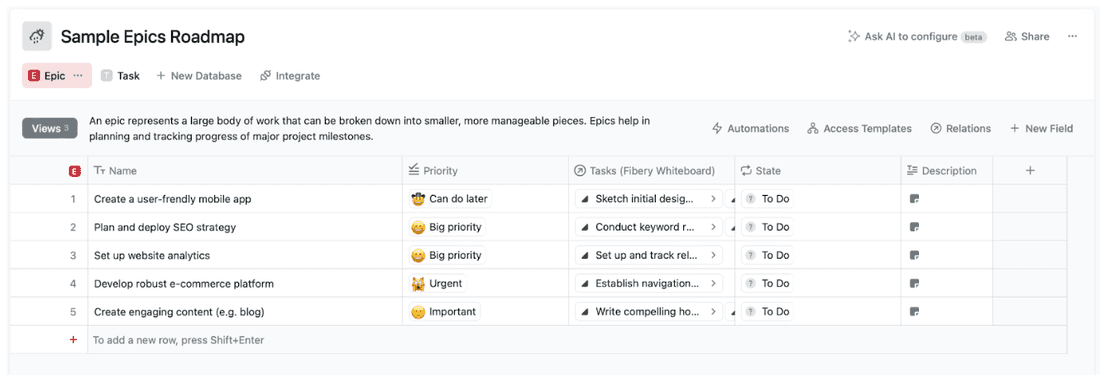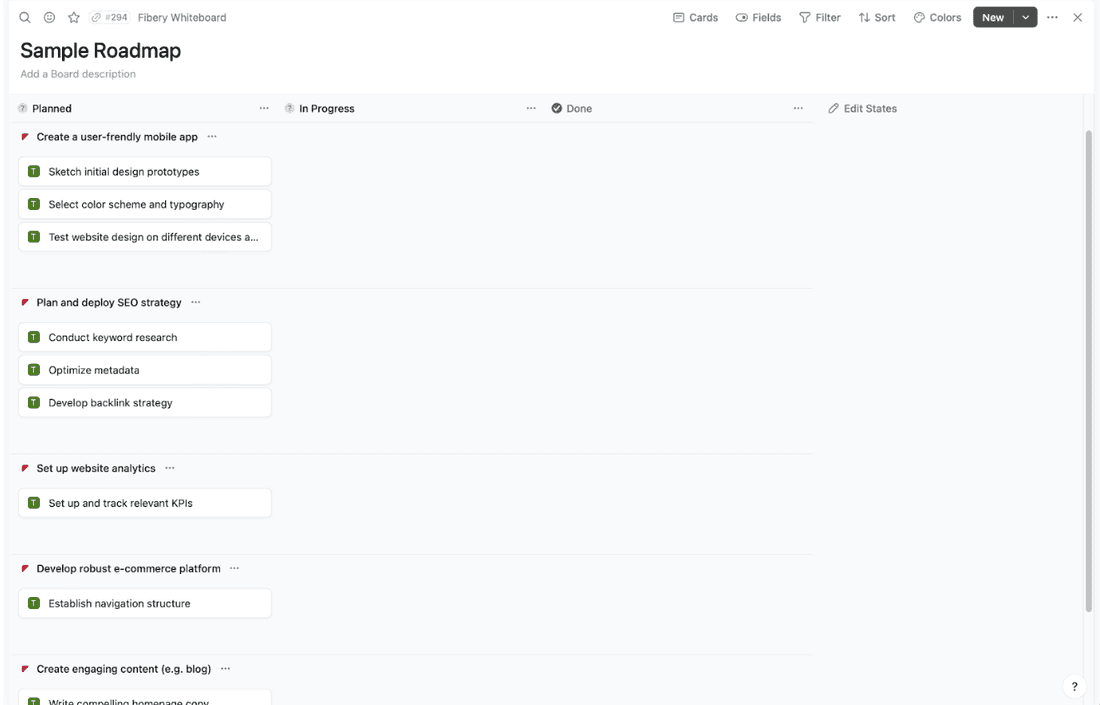Reaching Goals with Epics in Roadmaps
If you’re new to the term ‘epics,’ it might sound intimidating. Are we talking about a dramatic reenactment of your product roadmap? Are we telling you you’ve got to tackle tasks on the scale of King Arthur’s sword-pulling feat?
Epics are a big part of your product story – in scale and in importance. But rather than exist to overwhelm you, they actually help you figure out where your product development is heading.
Here’s a snapshot of what we’ll be looking at in this post:
- Breaking down the mighty concept of Epics and how they differ from the ‘Epic roadmap’ tool
- How to create an Epics roadmap even if you’ve never done so before
- Why it’s important to have Epics in a roadmap and for proper product planning
What is an Epics Roadmap?
The word epic is grand, heroic, ambitious, and extravagant, and how it’s used in product management very much reflects that.
Epics are the broad bodies of work that can be broken down into smaller tasks. They’re the big accomplishments you want to achieve on your roadmap, and they could take many sprints or months to complete.
Because of their lengthy timelines, they’re composed of smaller ‘Stories’ or ‘Tasks’, which act sort of like mini scrum roadmaps. It’s important not to get Epics roadmaps confused with Jira’s Epic Roadmap tool though – that’s software relating to project management.
If you’re planning to launch a brand of artisanal gelato, that would be considered an Epic. The Stories then include tasks like sourcing your ingredients, designing enticing packaging, and crafting interesting flavors.
When you use Epics the right way, you’ll garner a whole new sense of direction and a level of clarity that brings the whole company together.
How to Create an Epics Roadmap
No story or roadmap is a linear journey. It’s complex and multilayered, with plenty of highs and lows, conflicts and resolutions, and diverse characters playing different roles and responsibilities. With this step-by-step guide, though, you’ve got yourself a way to craft your own Epics roadmap and keep things on track.
- Figure Out Your Vision: There’s no purpose in mapping out an entire roadmap without a ‘why’ behind it all. Your first course of action is to look at the big picture and set some wider goals, whether it’s to penetrate a new market segment or create an awesome product that will solve a pressing issue.
- Pinpoint Your Epics: With these goals in place, it’s time to reveal those Epics. Ask yourself, “What major parts need to be achieved for the product to be successful?” For a website, for instance, you might have “create a user-friendly mobile app” and “implement a secure payment gateway” as two of the Epics.
- Break Epics Down into Stories or Tasks: It’s totally unrealistic to go off and have your teams work on these Epics as-is. With a goal so lofty as “create an app,” no one will know where to begin. Instead, you’ll need to reduce that complexity by creating independently achievable goals like “create wireframes” and “conduct market research.”
- Prioritize Your Epics: While all Epics are important, they still maintain their own priority based on your end goal, timelines, and feasibility. If your business objective right now is to create a platform to sell your product online, it’s obvious that developing the e-commerce platform is a top priority. Tasks like implementing a payment gateway are absolutely essential, too, as they will impact your ability to sell.

- Create a Visual Roadmap: The most appealing part about creating a roadmap is the fact that you can get creative and visual. Scrap the to-do list – your Epics and their subtasks can be laid out on a digital platform with colors, labels, and more that help everyone understand the project flow. As your roadmap changes, you can simply edit in real-time to your liking.

- Assign Responsibilities: In order to have a sense of ownership and accountability, each task should have a team member allocated to it, along with a deadline and expected deliverables.
- Review and Adjust Your Roadmap: Is a roadmap ever really truly done? Not exactly – but that isn’t necessarily a bad thing. The incredible thing about Epics roadmaps is that they’re dynamic and changeable. So, while you have a useful structure to go off of, it doesn’t mean you’ll be tied down to it indefinitely.
Why Bother Having an Epics Roadmap?
It certainly takes time and resources to create an Epics roadmap, so why go through the trouble?
- Gain Clarity: Having an Epics roadmap will let you materialize the entire vision and goals of a project. It provides a visual representation of the entire product journey built from a variety of Epics to help understand how all tasks interlink.
- Plan More Effectively: With the structure of Epics and their Stories, you’ll get a better idea of how you should plan tasks based on priority. You won’t be blind-sided by tasks you hadn’t thought of before and catch those potential roadblocks early.
- Get Your Team on the Same Page: When all Epics are mapped out for everyone, each team member will know why and what they’re doing in the broader scope of the project.
- Improve Communication: Epics roadmaps foster communication in two ways: by making the project trajectory easier to understand and follow and providing a memorable way to present a product roadmap.
- Become More Resilient: Circumstances change, and obstacles can pop up out of the blue, but an Epics roadmap can support the success of your project even when these things happen.
The PM’s Hot Take
People often underestimate Epics and see them simply as just big chunks of work. Change that perspective, look at each Epic as a milestone, and you’ll want that your team isn’t just fumbling around with a bunch of task lists. Epics are the real deal, giving us a full-on strategy to follow and get to those goals succinctly and effectively.
Conclusion
Product management becomes mega simple when you use Epics in your roadmaps. You’ve got the benefits of aim, collaboration, and serious visibility with regular roadmaps and then the boost that comes with Epics – making big, important goals more manageable.
Thinking of making the switch to an Epic-based roadmap? Why not take it for a test drive? With a 14-day free trial of Fibery, you can experiment with a variety of creative product management spaces and experience a renewed strategy that you’ve only ever dreamed of. Want to pick our brains a little more? Check out our blog for everything product management.
Psst... Wanna try Fibery? 👀
Infinitely flexible product discovery & development platform.